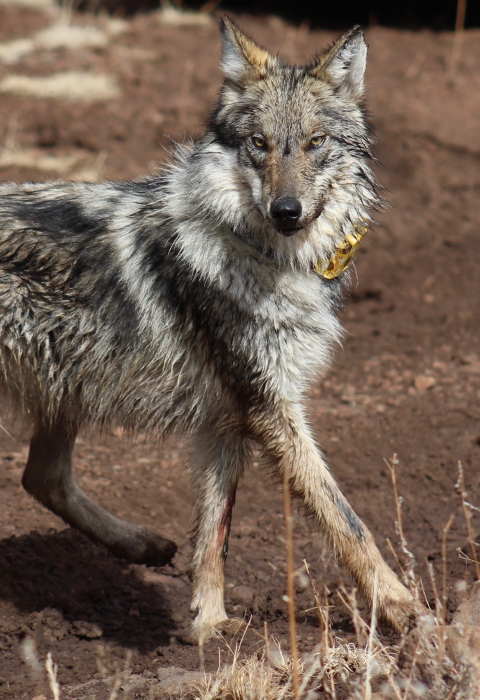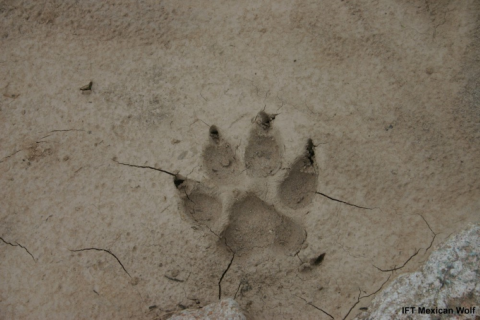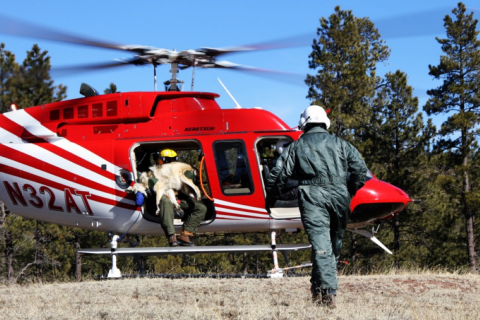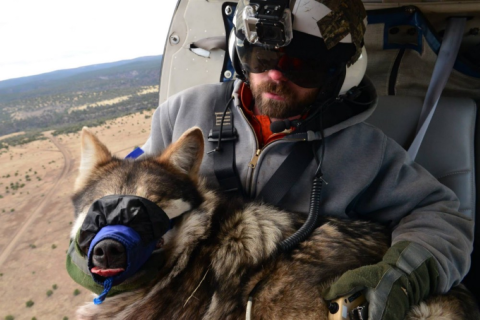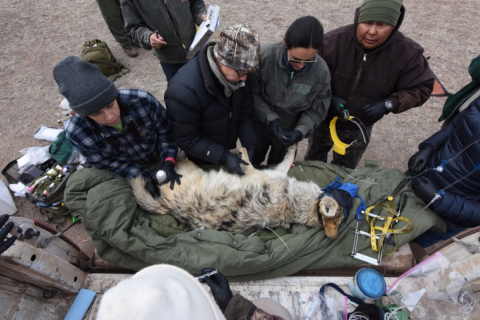Have you ever wondered how biologists “count” wildlife populations? For the Mexican wolf, it takes a coordinated effort across multiple state, federal, and tribal agencies over several months. It’s a process that involves detailed planning, trained aerial darters, multiple aircraft, and good weather.
Numbers continued to grow in 2021
The annual Mexican wolf count is an integral part of the Mexican Wolf Recovery Program. By providing information about the minimum number of wolves, packs, breeding pairs, and pups in the wild, the count tracks progress toward reaching recovery goals for this endangered species.
In 2021, the annual count documented a 5% increase in the wild population of Mexican wolves, raising the total number of wolves in the wild to a minimum of 196 animals. This marks the sixth consecutive year of growth in the wild population.
The most recent count also found that at the end of 2021, there were at least 45 packs of wolves. A wolf pack is defined as two or more wolves that maintain an established territory.
A minimum of 144 pups were born in 2021, and at least 56 survived to the end of the year — a 38% survival rate. Average survival of Mexican wolf pups in their first year is around 50%.
How radio collars contribute to conservation
The U.S. Fish and Wildlife Service’s annual Mexican wolf count starts in earnest every fall. Beginning in October, Mexican Wolf Interagency Field Team (Interagency Field Team) staff conduct ground counts across Arizona and New Mexico. During this time, wolves are documented by driving on roads and hiking canyons, trails, or other areas closed to motor vehicles. Biologists use GPS locations and radio signals from collared wolves to find the wolf packs and obtain visual observations. Confirmation of uncollared wolves is achieved through visual observation, remote cameras, howling, scat (poo or droppings), and tracks.
Efforts are also made to document pup survival. Priority is given to Mexican wolf packs with pups that were cross-fostered in the spring. All the survey data are then recorded in a database and used to make management decisions.
Planning for a successful count
Once the database is complete, targets for the count and capture are identified by the Interagency Field Team. At the top of the list are Mexican wolf packs without any radio tracking collars, followed closely by wolves with failing collars. The radio tracking collars use GPS and very high frequency (VHF) technology and are essential tools in the management of wild wolves.
Radio collars track movements of individual wolves and packs as well as let the Interagency Field Team know when wolves are denning (and pups are being whelped) and when a death occurs.
Radio collars also help the Interagency Field Team manage wolves to mitigate and avoid attacks on cattle through a variety of non-lethal techniques, such as hazing wolves, range riders and providing diversionary food caches to avoid depredations.
Once the list of target wolves and packs has been developed, the days are planned out and the aerial portion of the wolf count is ready to begin.
An aerial approach
The aerial operation portion of the Mexican wolf count is conducted much like an orchestra — each person has a role to play — all in harmony. Instead of flutists, violinists, trumpeters, and drummers, however, there are pilots, aerial darters, muggers, and veterinarians working together to ensure that everyone (people and wildlife!) stays safe and achieves conservation goals. A helicopter darter uses darts with tranquilizers to sedate wolves, while a mugger is a person that helps locate, count and capture wolves from a helicopter.
Two aircraft are used in the annual Mexican wolf count and capture. A spotter plane uses radio location equipment to locate the day’s target wolves. Once the spotter plane has a location, it’s relayed to the helicopter below.
When the helicopter locates a Mexican wolf pack, the crew on board counts the number of wolves in the pack from the air. If a target wolf is located, and if the surrounding terrain accommodates a safe capture attempt, the helicopter darter will attempt to tranquilize the wolf from the air.
If a dart goes in and a wolf succumbs to the effects of the tranquilizer, the helicopter will land and the helicopter darter and mugger will retrieve the sedated wolf. There’s a quick check of the wolf’s vital signs before it’s carried back to the helicopter. Once the air crew and wolf are safely secured, the helicopter transports the wolf to the nearest ground crew for processing.
A quick health check
When word comes in that a Mexican wolf has been darted and tranquilized, ground crews of trained biologists prepare to receive and process the wolf.
The lead processor guides the crew as they conduct a health examination of the wolf, administer vaccines, draw blood, take body measurements, and fit it with a tracking collar. A veterinarian monitors the health of the sedated wolf throughout the process to ensure safety for the wolf and the crew. Finally, a new radio collar is attached and its frequency is recorded along with the rest of the wolf’s information.
After processing is completed, the wolf is crated and monitored as the sedation drug wears off. Once the animal is ready to be released back to the wild, it’s loaded onto a truck, UTV, or snowmobile, and it is returned to its territory in the National Forest.
This health inspection and the collaring process are repeated multiple times a day for a 10- to 14-day period. Once aerial operations conclude, it’s time to crunch the numbers and determine the previous year’s final population estimate.
When will the Mexican wolf population count be announced?
Our biologists and partners review count data in the weeks following the count operations. Mexican wolf census data is generally available by spring. The 2021 population survey was released on March 30, 2022.
Thank you to the many partners who help with Mexican wolf recovery, including Arizona Game and Fish Department, New Mexico Department of Game and Fish, U.S. Forest Service, USDA-APHIS Wildlife Services, White Mountain Apache Tribe, Bureau of Land Management, and the U.S. National Park Service.
